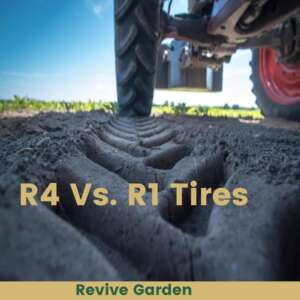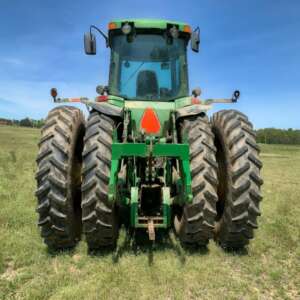Table of Contents
 For your safety and the efficient functioning of your machine, selecting the correct tractor tire size is crucial. There are many different sizes and types of tractor tires.
For your safety and the efficient functioning of your machine, selecting the correct tractor tire size is crucial. There are many different sizes and types of tractor tires.
Each has specific performance properties with so many alternatives that the argument between R14 Tires and R4 rages on with no apparent winner.
The letter R on a tractor tire denotes radial construction. There are a few distinctions between R1 and R4 tires. R4 tractor tires are preferred by some people, while others use R tractor tires.
Both tire types have advantages, so choosing one over the other might be challenging.
In this article, we will discuss the difference between R1 and R4 tires and will see which one is best among them. If interested, keep reading!
Difference Between R1 And R4 Tires
What is the major distinction? R1 tires are primarily utilized in farming on dry ground or in areas with moderate to good soil. For work in the highway department or the factories, an R4 tire is ideal. Work has been done in various fields, such as agriculture, construction, and industry. Each characteristic has been evaluated against each factor, and the results are listed below:
Safety And Ease Of Use
The tires’ weight ratings differ. R4 tires have a considerably higher weight rating than R1 tires. Sixty pounds in the front and 40 in the back is the ideal weight ratio for your tire. Let’s say the loader has a big bucket on it. The tractor will become severely out of balance if you have R1 tires on the front and the bucket is unfilled (not the loader).
The front tires will sag considerably. The tires also become overloaded when you load. So it appears uncomfortable to use R1 tires up front. Additionally, working with the soft R1 tires in mud or dirt will be risky. If one of the front tires blows out while transporting something big in this scenario, it will be quite dangerous! R4 tires do, however, lack lateral traction. Moreover, due to its design, it destroys property.
Durability
There isn’t much of a distinction, in our opinion. You could have to deal with both. Performance seems to be the same on the most common surface. No matter the tire, it’s usually preferable to avoid areas where the ground is continually wet because it demands more aggressive traction.
That is just our perspective. You could assume that because the R4 tires are sturdier than the R1 ones, they are much more durable. However, there is little solid support for that claim.

Performance
If we compare the R1 and R4 tires’ performance on the common ground, there isn’t much of a difference. However, the performance varies in mud and other situations. According to reports, changes have caused R4 tries to become more stuck in the mud.
The R1 tires are softer and springier than the R4 tires. On the other hand, R4 tires are very hard. They possess a solid sidewall. For reasons related to safety, this is essential.
Reliability
Without a doubt, R1 tires offer better traction in almost every situation. Possibly except use on asphalt and concrete, though. The overall ply strength and puncture resistance of R4s are slightly higher than those of R1s. The R1s also cause a little less damage to the ground.
R4s have at least six plies, though. In comparison to four-ply tires, six-ply tires are 50% more durable. Strong Loader loads cause R4s to drop relatively little, exposing the expanded sidewalls of R1 tires.
Resell Worth
When it comes to tires, you can tell that used tires older than 2-3 years don’t have a high resale value. However, people are more likely to purchase a used R4 than an R1—the tire needs to be in acceptable shape.
General Effectiveness
R1 tires are the most effective at maintaining traction. The R4 tires have the strongest weight support. Due to its effectiveness, it is challenging to determine the overall efficiency in a single calculation.
Price contrast
The R1 tire is $30 to $250. However, the R4 costs between $100 and $500. Due to their superior snow plowing capabilities and tread pattern, R4 tires cost more than R1. They cost more than R1s, but in our opinion, they don’t have as much traction. However, the R4s have a significantly longer lifespan.
Which Tractor Tire Should I Choose: R1 or R4?
The decision of which one to choose is now necessary! But as we previously mentioned, choosing the right tires is not always simple. But mixing these tires will solve the problem! It would help if you had an R1 rear and an R4 front setup. When making your decision, measure the wheel’s width because the R4 front tire needs a wider wheel than an R1 tire.
Another thing to keep in mind is the rolling circumference at the tread. For this aspect, moving to R1 rears shouldn’t be a problem. Performance changes in the tires’ air pressure and tread wear will also have an impact. The spinning ratio of larger tires can rise by a proportion of one due to the difference in tire diameter.
It would help if you also changed the center discs and rear R1 tire rims. It is less expensive to replace just the rear tires with new wheels and discs than to buy four sets of tires, rims, and discs. But after everything is finished, you can anticipate positive outcomes.
FAQs
What is SS on tractor tires?
It is a code that represents the potential top speed that a tire may go.
Are R1 tires suitable for snow?
R1 Tires. Deep treads on R1 tires, sometimes agriculture tires, provide grip in even the most difficult field conditions. R1 tires that are correctly inflated will give you the traction you need for almost any task, whether you’re working in mud, loose dirt, or snow.
Conclusion
A sturdy and efficient tire is crucial for properly working a lawn mower. R1 and R4 are perfect in their space, but if you want a long-lasting and powerful tire for your mower, We advise using both in combination. However, if you don’t have the money, you can pass with the R1s for the loader job. We hope this encapsulates it for you!
